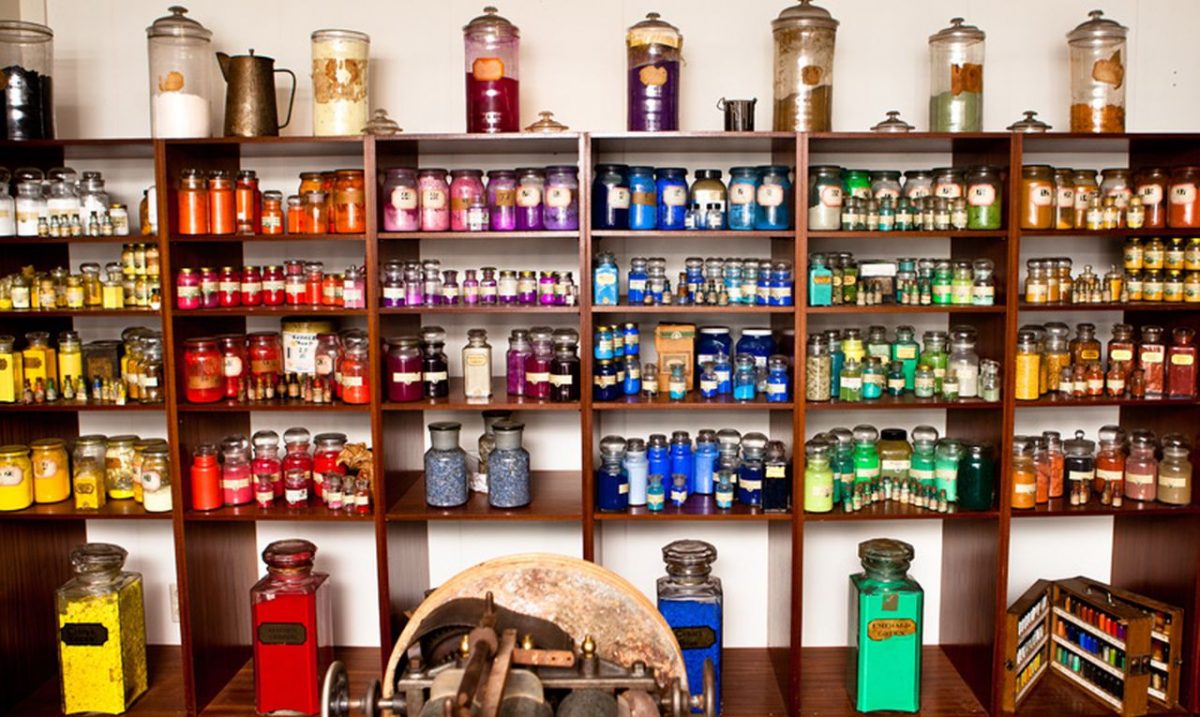
Everything you need to know about paint (part 3)
click here for Everything you need to know about paint (part 1)
click here for Everything you need to know about paint (part 2)
Artificial pigments
All pigments, and, accordingly, all the paints derived from them, can be divided into two main groups: natural ones and synthetic ones.
Synthetic pigments can be further divided into organic and non-organic ones.
Synthetic mineral-based pigments are obtained as a result of chemical interactions between two or three, or more, ingredients. Based on the way they are obtained, they are divided into those that are strained from salt and metal solutions, and those obtained through burning. Here, in brief, are the characteristics of the most common organic and non-organic synthetic pigments in the modern artist’s color palette.
White pigments
White lead, which is obtained by oxidizing lead with strong vinegar, was for millennia the principal white pigment, and remained so up until the mid-nineteenth century.
White lead is mentioned by many classical authors. Its main advantage lies in its large covering ability and its ability to dry quickly (in oil paints), right down to the bottom of the layer of paint. It is this property that makes it so irreplaceable for oil clays. White lead does have its downsides, however: it is very poisonous, and must therefore be handled extremely carefully, and it can turn black under the impact of the hydrogen sulfide in air, particularly in watercolours and gouache, where they are not protected by enough binding agent. White lead reacts negatively to an alkaline environment, and therefore cannot be used in frescoes.
White lead is a bright-white, high-dispersion powder tinged with light blue. The pigment was discovered in the late 18th century, and from the mid-nineteenth century onwards it began to displace white lead, even though it has less to offer in terms of covering ability, oil content and speed of drying. Zinc white is very lightfast and creates a good white paint with a variety of binders. In oil paints, though, in many artists’ opinion, they are somewhat worse than white lead, since they have a greater oil content and dry more slowly. A slow drying speed is not always seen as a disadvantage, however; in some cases, on the contrary, it is desirable for an artist.
Yellow pigments
Among the synthetic yellow pigments, one that has been used since the middle of the last century is strontium yellow – a high-dispersion yellow powder with a green-ish hue. This pigment wears well, forming an easily spreadable paste, but it has limited lightfastness. Under light, its green-ish hue becomes more noticeable. This greenness also manifests itself noticeably when the color is mixed with whites.
In 1829, cadmium was discovered, and from the middle of the century onwards, a host of yellow and red paints appeared that were based on this metal. Yellow cadmium is made in four different shades: lemon, light, medium and dark. Cadmium yellow lemon is similar in tone to strontium yellow, and can be used as a substitute for it. Yellow cadmium has a high intensity, and has good spreadability with all binders. Mixing it with blue pigments results in beautiful green tones.
Green pigments
When it comes to synthetic green pigments, one that is widely used nowadays is chromium oxide green – a pale, olive-green pigment that is resistant to the effects of light and moisture. It started being used as an artistic paint in 1862. This pigment has a high degree of covering ability and therefore cannot really be used in watercolors.
Emerald green, a bright-green pigment, was discovered in 1797, and has been used in painting since 1838. This pigment is noteworthy on account of its high glazing capacity, though repeated grinding is required for this; it is resistant to the effects of light, moisture and gases, and can be used for all types of artistic paints.
Blue pigments
Cobalt blue is a bright-blue dispersion powder that was first used for the manufacturing of artistic paints in 1802. This pigment is resistant to the effects of light and the atmosphere, and has glaze-forming and siccative properties. It is difficult to spread with binders, has a large oil content and a low covering ability, and has deep, red tone of color, but it loses its sheen in thick, pasty layers. When extracted as a substrate in zinc white, it forms light blue cobalt.
One of the oldest synthetic blue paints, which is widely used today, is Prussian Blue. Discovered in 1704, it became very popular from the mid-eighteenth century onwards. This pigment is resistant to light and has a high covering ability and intensity, but it changes its color tone with white lead.
Synthetic ultramarine is obtained by heating kaolin with soil infusion, sodium carbonate, sulfur and charcoal. It was discovered in 1826 and soon displaced natural ultramarine, as it was cheaper and its properties were just as good as those of natural ultramarine.
Black pigments
Carbon black (also known as lampblack, lamp soot) is a high-dispersion pigment that is almost pure carbon, obtained by burning carbon-rich matter. With its high level of dispersion, lampblack, when used in oil paints, can penetrate from a lower layer to the upper ones. The pigment also has a large oil content and is slow to dry. It is used to produce black mascara, typographic paint and watercolor paint. Resistant to the effects of moisture, it has a good covering ability. It is used in the manufacture of all kinds of artistic paints.
Peach black is a deep black pigment with a blue-ish tint, obtained from peach stones, which are burnt with a limited air supply. This pigment has a good covering ability and good resistance when mixed. It is used for all types of artistic paints.
Synthetic pigments, which offer the best resistance to light, moisture, and the effects of gases and the atmosphere, and which also come in brighter shades, have long been front and central in the modern artist’s palette.







